![]()
![]()
![]()
Use LEFT and RIGHT arrow keys to navigate between flashcards;
Use UP and DOWN arrow keys to flip the card;
H to show hint;
A reads text to speech;
33 Cards in this Set
- Front
- Back
|
Osmoregulation |
Controls solute concentrations and balances water gain and loss Relative concentration of water and solutes must be maintained within narrow limits |
|
|
Excretion |
Rids body of nitrogenous metabolites and other waste products |
|
|
Driving force for movement of water and solutes... |
Diffusion and osmosis on a concentration gradient across plasma membrane |
|
|
Osmolarity |

Solute concentration of a solution Determines which way the water will move |
|
|
Isoosmotic |
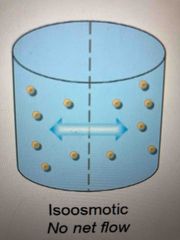
Water molecules cross membrane at equal rates in both directions |
|
|
Hyposmotic |
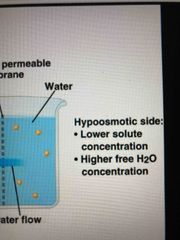
Less concentrated, more water |
|
|
Hyperosmotic |
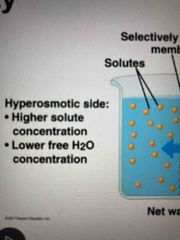
More concentrated, less water |
|
|
Hypertonic vs hypotonic of cell |
Hyper: will lyse Hypo: will shrivel |
|
|
Osmoconformers |
Isoosmotic with their surroundings, do not regulate osmolarity |
|
|
Osmoregulator |
Expend energy to control water uptake and loss in a hypo or hyperosmotic environment Benefits have allowed for us to move to land |
|
|
Stenohaline |
Narrow salt Cannot tolerate substantial changes in external osmolarity This is us |
|
|
Euryhaline |
Broad salt Animals can survive large fluctuations in external osmolarity |
|
|
Marine animals |
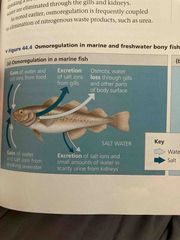
Most invertebrates are osmoconformers Most vertebrates and some inv. Are osmoregulators More likely to be hypoosmotic to seawater (always losing water) To manage this: drink large amounts of seawater and eliminate ingested salts through their gills and kidneys
|
|
|
Freshwater animals |
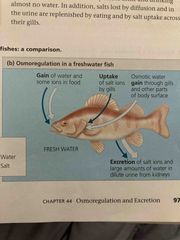
Constantly taking in water. Hyperosmotic Lose salt by diffusion due to this so they maintain balance by drinking almost no water and excreting large amounts of dilute urine Salt lost by diffusion are replaced in foods and by uptake across gills |
|
|
Anhydrobiosis |
Adaptations for animals that Live in puddles Lose almost all their body water and survive in a dormant state ie: Tardigrade: dehydrates from 85% water to 2% water in the dehydrated inactive state. Have high concentration of trehalose (sugar that serves as water in a gel) |
|
|
Adaptations for land animals |
Body coverings: wax, shells, skin Nocturnal: at night prevents evaporation of water from sun Maintain water balance by eating moist food and producing water through cellular respiration |
|
|
Osmoregulators expend ebergy |
Amount of energy differs based on: How different animal’s osmolarity is from its surroundings How easily water and solutes move across animals surface Work required to pump solutes across membrane |
|
|
Transport epithelia |
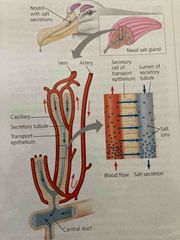
Specialized of epithelial cells that control movement of solutes in specific directions Arranged with tubular networks Nasal glands of marine birds removed excess salt from blood (countercurrent system) |
|
|
Nitrogenous waste reflects animals habitat and phylogeny |
Type and quantity of waste may affect water balance Waste includes nitrogenous, proteins, and nucleus acids in forms of: ammonia, urea, and Uric acid (least toxic) These differ in toxicity and energy cost |
|
|
Ammonia |
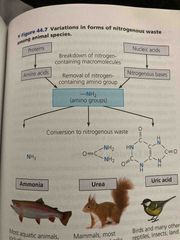
Animals that excrete nitrogenous waste as ammonia need access to lots of water Ammonia is high toxicity (need water to get rid of it) yet easy to make Often fish and invertebrates bc you need the water |
|
|
Urea |
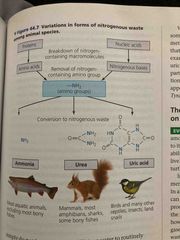
Less toxic than ammonia yet energy costing (converts from ammonia to urea cost energy) Requires less water to excrete In most mammals and many marine species |
|
|
Uric acid |
Insects, snails, reptiles, birds Nontoxic Does not dissolve readily in water and more like a paste with little water loss Much more costly energy wise |
|
|
3 things leads to how to excrete.. |
1. Animals environment and history (fish have more water, but others not having more water so fish use ammonia) 2. Immediate environment of egg (Uric acid is safe in egg vs other two) 3. Amount of nitrogenous waste is coupled with animals energy budget (higher energy budget=eating more which leads to more nitrogenous waste). Diet also plays role Endothermic bc exothermic |
|
|
Variations on a tubular theme |
Excretory systems regulate solute movement btw internal fluids and the external environment Central to homeostasis |
|
|
Excretory process |
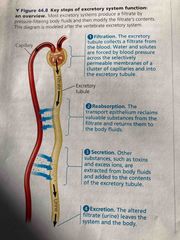
Most systems produce urine, a refined filtrate derived from fluids (blood) 4 steps: Filtration: nonspecific as to what is coming out Reabsorption: reclaiming valuable solutes Secretion: adding nonessential solutes and waste (toxins/drugs) to filtrate Excretion: processed filtrate (including nitrogenous waste) is released from body |
|
|
Other systems |
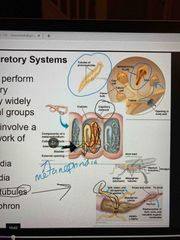
Still based on tubules network Protonepheidia: Metanphridia: drawing fluid in from a segment into yellow tubule network with capillary network controlling what goes in and out (worms have one in each segment) Malpighian tubules: dead end tubes lined with transport epithelia into digestive tract Kidneys/nephron |
|
|
Excretory organs |
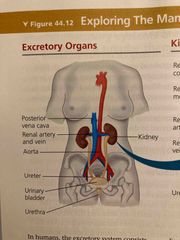
Back (Definition) |
|
|
Kidneys |
Function in excretion and osmoregulation Numerous tubules highly organized Excretory system Includes ducts and other structures that carry urine from the tubules out of the kidney and out of the body |
|
|
Excretory organs |
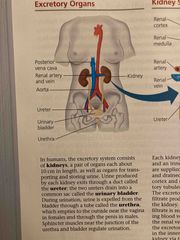
Back (Definition) |
|
|
Kidney structure |
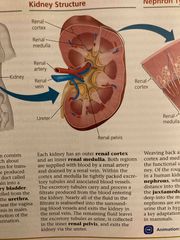
A |
|
|
Nephron types |
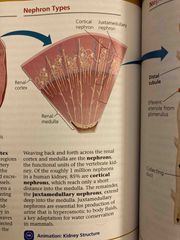
A |
|
|
Nephron organization |
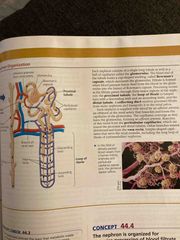
A |
|
|
During nephron process filter how much water? |
180 L of fluid, recover 99% |

